Viet Anh Nguyen
Structured Pruning for Diverse Best-of-N Reasoning Optimization
Jun 09, 2025Abstract:Model pruning in transformer-based language models, traditionally viewed as a means of achieving computational savings, can enhance the model's reasoning capabilities. In this work, we uncover a surprising phenomenon: the selective pruning of certain attention heads leads to improvements in reasoning performance, particularly on challenging tasks. Motivated by this observation, we propose SPRINT, a novel contrastive learning framework that dynamically selects the optimal head and layer to prune during inference. By aligning question embeddings with head embeddings, SPRINT identifies those pruned-head configurations that result in more accurate reasoning. Extensive experiments demonstrate that our method significantly outperforms traditional best-of-$N$ and random head selection strategies on the MATH500 and GSM8K datasets.
Mixture-of-Personas Language Models for Population Simulation
Apr 07, 2025


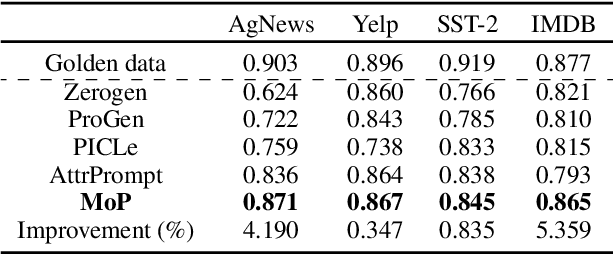
Abstract:Advances in Large Language Models (LLMs) paved the way for their emerging applications in various domains, such as human behavior simulations, where LLMs could augment human-generated data in social science research and machine learning model training. However, pretrained LLMs often fail to capture the behavioral diversity of target populations due to the inherent variability across individuals and groups. To address this, we propose \textit{Mixture of Personas} (MoP), a \textit{probabilistic} prompting method that aligns the LLM responses with the target population. MoP is a contextual mixture model, where each component is an LM agent characterized by a persona and an exemplar representing subpopulation behaviors. The persona and exemplar are randomly chosen according to the learned mixing weights to elicit diverse LLM responses during simulation. MoP is flexible, requires no model finetuning, and is transferable across base models. Experiments for synthetic data generation show that MoP outperforms competing methods in alignment and diversity metrics.
Task-driven Layerwise Additive Activation Intervention
Feb 10, 2025



Abstract:Modern language models (LMs) have significantly advanced generative modeling in natural language processing (NLP). Despite their success, LMs often struggle with adaptation to new contexts in real-time applications. A promising approach to task adaptation is activation intervention, which steers the LMs' generation process by identifying and manipulating the activations. However, existing interventions are highly dependent on heuristic rules or require many prompt inputs to determine effective interventions. This paper proposes a layer-wise additive activation intervention framework that optimizes the intervention process, thus enhancing the sample efficiency. We benchmark our framework on various datasets, demonstrating improvements in the accuracy of pre-trained LMs and competing intervention baselines.
Probe-Free Low-Rank Activation Intervention
Feb 06, 2025



Abstract:Language models (LMs) can produce texts that appear accurate and coherent but contain untruthful or toxic content. Inference-time interventions that edit the hidden activations have shown promising results in steering the LMs towards desirable generations. Existing activation intervention methods often comprise an activation probe to detect undesirable generation, triggering the activation modification to steer subsequent generation. This paper proposes a probe-free intervention method FLORAIN for all attention heads in a specific activation layer. It eliminates the need to train classifiers for probing purposes. The intervention function is parametrized by a sample-wise nonlinear low-rank mapping, which is trained by minimizing the distance between the modified activations and their projection onto the manifold of desirable content. Under specific constructions of the manifold and projection distance, we show that the intervention strategy can be computed efficiently by solving a smooth optimization problem. The empirical results, benchmarked on multiple base models, demonstrate that FLORAIN consistently outperforms several baseline methods in enhancing model truthfulness and quality across generation and multiple-choice tasks.
Risk-Aware Distributional Intervention Policies for Language Models
Jan 27, 2025Abstract:Language models are prone to occasionally undesirable generations, such as harmful or toxic content, despite their impressive capability to produce texts that appear accurate and coherent. This paper presents a new two-stage approach to detect and mitigate undesirable content generations by rectifying activations. First, we train an ensemble of layerwise classifiers to detect undesirable content using activations by minimizing a smooth surrogate of the risk-aware score. Then, for contents that are detected as undesirable, we propose layerwise distributional intervention policies that perturb the attention heads minimally while guaranteeing probabilistically the effectiveness of the intervention. Benchmarks on several language models and datasets show that our method outperforms baselines in reducing the generation of undesirable output.
GROOT: Effective Design of Biological Sequences with Limited Experimental Data
Nov 18, 2024



Abstract:Latent space optimization (LSO) is a powerful method for designing discrete, high-dimensional biological sequences that maximize expensive black-box functions, such as wet lab experiments. This is accomplished by learning a latent space from available data and using a surrogate model to guide optimization algorithms toward optimal outputs. However, existing methods struggle when labeled data is limited, as training the surrogate model with few labeled data points can lead to subpar outputs, offering no advantage over the training data itself. We address this challenge by introducing GROOT, a Graph-based Latent Smoothing for Biological Sequence Optimization. In particular, GROOT generates pseudo-labels for neighbors sampled around the training latent embeddings. These pseudo-labels are then refined and smoothed by Label Propagation. Additionally, we theoretically and empirically justify our approach, demonstrate GROOT's ability to extrapolate to regions beyond the training set while maintaining reliability within an upper bound of their expected distances from the training regions. We evaluate GROOT on various biological sequence design tasks, including protein optimization (GFP and AAV) and three tasks with exact oracles from Design-Bench. The results demonstrate that GROOT equalizes and surpasses existing methods without requiring access to black-box oracles or vast amounts of labeled data, highlighting its practicality and effectiveness. We release our code at https://anonymous.4open.science/r/GROOT-D554
Range-aware Positional Encoding via High-order Pretraining: Theory and Practice
Sep 27, 2024Abstract:Unsupervised pre-training on vast amounts of graph data is critical in real-world applications wherein labeled data is limited, such as molecule properties prediction or materials science. Existing approaches pre-train models for specific graph domains, neglecting the inherent connections within networks. This limits their ability to transfer knowledge to various supervised tasks. In this work, we propose a novel pre-training strategy on graphs that focuses on modeling their multi-resolution structural information, allowing us to capture global information of the whole graph while preserving local structures around its nodes. We extend the work of Wave}let Positional Encoding (WavePE) from (Ngo et al., 2023) by pretraining a High-Order Permutation-Equivariant Autoencoder (HOPE-WavePE) to reconstruct node connectivities from their multi-resolution wavelet signals. Unlike existing positional encodings, our method is designed to become sensitivity to the input graph size in downstream tasks, which efficiently capture global structure on graphs. Since our approach relies solely on the graph structure, it is also domain-agnostic and adaptable to datasets from various domains, therefore paving the wave for developing general graph structure encoders and graph foundation models. We theoretically demonstrate that there exists a parametrization of such architecture that it can predict the output adjacency up to arbitrarily low error. We also evaluate HOPE-WavePE on graph-level prediction tasks of different areas and show its superiority compared to other methods.
Sampling Foundational Transformer: A Theoretical Perspective
Aug 11, 2024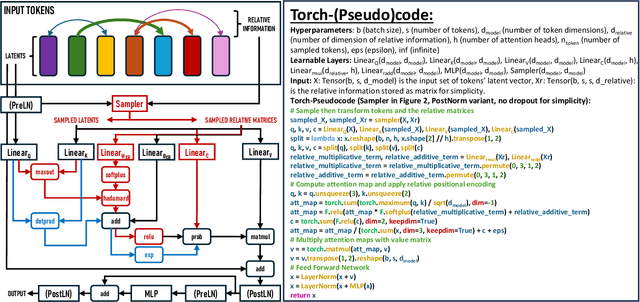
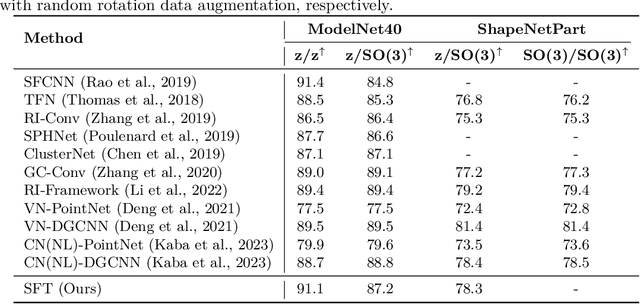
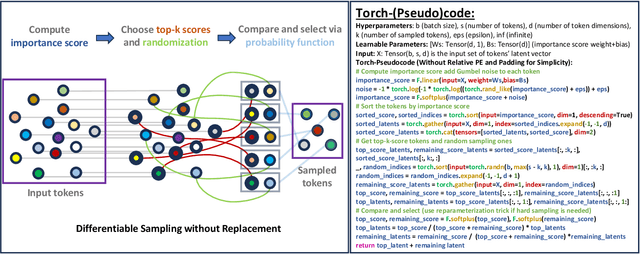
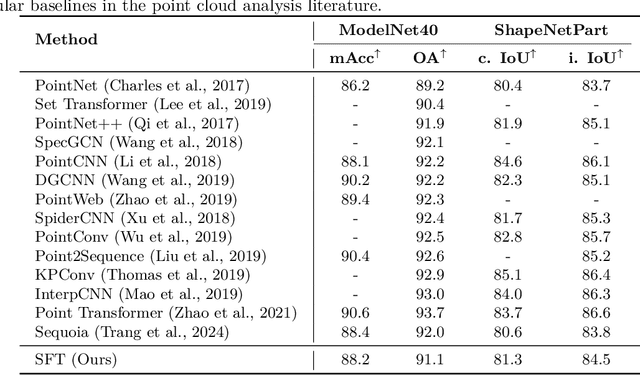
Abstract:The versatility of self-attention mechanism earned transformers great success in almost all data modalities, with limitations on the quadratic complexity and difficulty of training. To apply transformers across different data modalities, practitioners have to make specific clever data-modality-dependent constructions. In this paper, we propose Sampling Foundational Transformer (SFT) that can work on multiple data modalities (e.g., point cloud, graph, and sequence) and constraints (e.g., rotational-invariant). The existence of such model is important as contemporary foundational modeling requires operability on multiple data sources. For efficiency on large number of tokens, our model relies on our context aware sampling-without-replacement mechanism for both linear asymptotic computational complexity and real inference time gain. For efficiency, we rely on our newly discovered pseudoconvex formulation of transformer layer to increase model's convergence rate. As a model working on multiple data modalities, SFT has achieved competitive results on many benchmarks, while being faster in inference, compared to other very specialized models.
SAMSA: Efficient Transformer for Many Data Modalities
Aug 10, 2024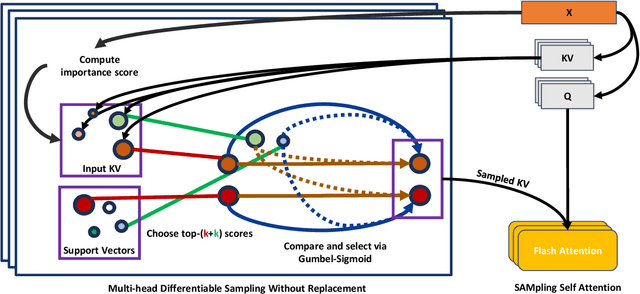
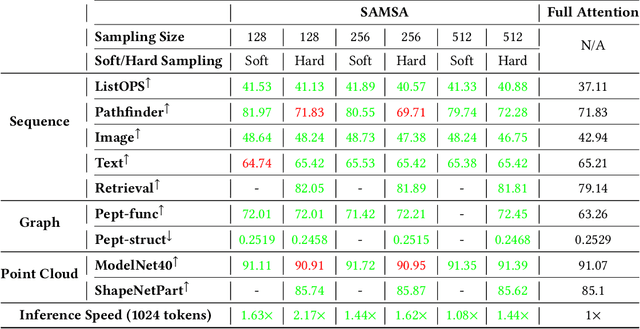

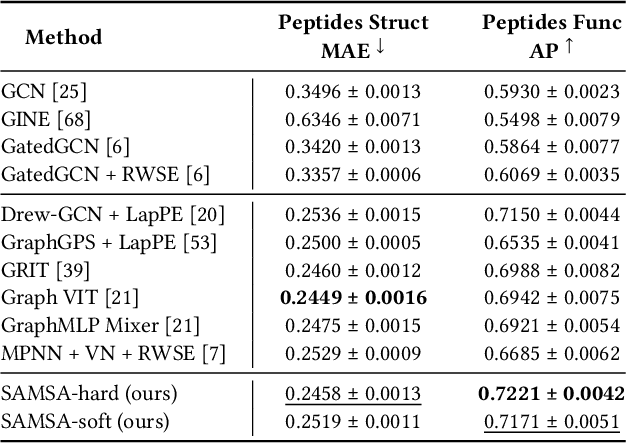
Abstract:The versatility of self-attention mechanism earned transformers great success in almost all data modalities, with limitations on the quadratic complexity and difficulty of training. Efficient transformers, on the other hand, often rely on clever data-modality-dependent construction to get over the quadratic complexity of transformers. This greatly hinders their applications on different data modalities, which is one of the pillars of contemporary foundational modeling. In this paper, we lay the groundwork for efficient foundational modeling by proposing SAMSA - SAMpling-Self-Attention, a context-aware linear complexity self-attention mechanism that works well on multiple data modalities. Our mechanism is based on a differentiable sampling without replacement method we discovered. This enables the self-attention module to attend to the most important token set, where the importance is defined by data. Moreover, as differentiability is not needed in inference, the sparse formulation of our method costs little time overhead, further lowering computational costs. In short, SAMSA achieved competitive or even SOTA results on many benchmarks, while being faster in inference, compared to other very specialized models. Against full self-attention, real inference time significantly decreases while performance ranges from negligible degradation to outperformance. We release our source code in the repository: https://github.com/HySonLab/SAMSA
Forget but Recall: Incremental Latent Rectification in Continual Learning
Jun 25, 2024



Abstract:Intrinsic capability to continuously learn a changing data stream is a desideratum of deep neural networks (DNNs). However, current DNNs suffer from catastrophic forgetting, which hinders remembering past knowledge. To mitigate this issue, existing Continual Learning (CL) approaches either retain exemplars for replay, regularize learning, or allocate dedicated capacity for new tasks. This paper investigates an unexplored CL direction for incremental learning called Incremental Latent Rectification or ILR. In a nutshell, ILR learns to propagate with correction (or rectify) the representation from the current trained DNN backward to the representation space of the old task, where performing predictive decisions is easier. This rectification process only employs a chain of small representation mapping networks, called rectifier units. Empirical experiments on several continual learning benchmarks, including CIFAR10, CIFAR100, and Tiny ImageNet, demonstrate the effectiveness and potential of this novel CL direction compared to existing representative CL methods.
 Add to Chrome
Add to Chrome Add to Firefox
Add to Firefox Add to Edge
Add to Edge